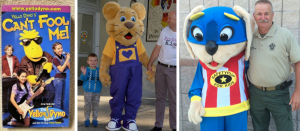One of our staff members is contributing considerably to a News Archiving service at Mu. Any well educated (Masters, PhD or above) users who wish to make comments on news sites, please contact Jim Burton directly rather than using this list, and we can work on maximising view count.
Child safety mascot: Difference between revisions
No edit summary |
No edit summary |
||
| Line 2: | Line 2: | ||
__NOTOC__'''A child safety mascot''' is a device used to warn children about the dangers posed by adults who make sexual advances. Usually based on an animal, the safety mascot is also active in setting boundaries for "appropriate behavior". | __NOTOC__'''A child safety mascot''' is a device used to warn children about the dangers posed by adults who make sexual advances. Usually based on an animal, the safety mascot is also active in setting boundaries for "appropriate behavior". | ||
The concept became a meme, in the form of Yello Dyno, a jive-talking yellow lizard who spawned a bizarre 1998 viral 40-minute video, in which sexually active [[hebephilia|hebephiles]] and a [[child | The concept became a meme, in the form of Yello Dyno, a jive-talking yellow lizard who spawned a bizarre 1998 viral 40-minute video, in which sexually active [[hebephilia|hebephiles]] and a [[child pornography|youth pornographer]] were referred to as "tricky people".<ref>https://www.imdb.com/title/tt11632620/</ref> | ||
Probably inspired by Yello Dyno, the concept was parodied by South Park, in the episode, ''Sexual Harassment Panda''. | Probably inspired by Yello Dyno, the concept was parodied by South Park, in the episode, ''Sexual Harassment Panda''. | ||
Revision as of 17:18, 6 November 2021

A child safety mascot is a device used to warn children about the dangers posed by adults who make sexual advances. Usually based on an animal, the safety mascot is also active in setting boundaries for "appropriate behavior".
The concept became a meme, in the form of Yello Dyno, a jive-talking yellow lizard who spawned a bizarre 1998 viral 40-minute video, in which sexually active hebephiles and a youth pornographer were referred to as "tricky people".[1]
Probably inspired by Yello Dyno, the concept was parodied by South Park, in the episode, Sexual Harassment Panda.
The idea has seen little adoption in the 2010s and 20s. This is thought to be because of the similarity of these mascots to the sometimes sexually-connoted fursuits used by furries to signal their creative impulses.